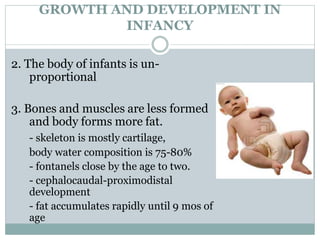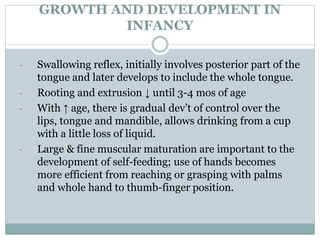Nlc infancy
- 1. INFANCY PRESENTED BY: CHARLES TAN, RND NUTRITION IN THE LIFE CYCLE
- 2. ADJUSTMENT MADE BY THE NEWBORN INFANT ï All the needs, nutritional, biological and physiological, of the fetus is provided by the uterus during conception. ï After birth, the infant must carry out essential functions on his own: 1) respiration 2) temperature control 3) changes in blood circulation 4) with the first feedingïĻ infant is responsible for his own digestion, absorption, assimilation and excretion
- 3. GROWTH AND DEVELOPMENT IN INFANCY 1. 1ST year is critical as infant grows in weight and height - NB: about 6-7 lbs. (2.7-3.2kg) & 18-20 in. (48-51cm) - 1st year: fastest growth until adolescence: BW is doubled by 5-6 mos. & tripled by 12 mos.; birth length is increased by 24cm by the end of the year.
- 4. GROWTH AND DEVELOPMENT IN INFANCY 2. The body of infants is un- proportional 3. Bones and muscles are less formed and body forms more fat. - skeleton is mostly cartilage, body water composition is 75-80% - fontanels close by the age to two. - cephalocaudal-proximodistal development - fat accumulates rapidly until 9 mos of age
- 5. GROWTH AND DEVELOPMENT IN INFANCY 4. Brain development: fastest in the first two years. - brain development is faster than any other system up to age one - brain is 25% of its adult weight at birth will reach 70-75% of its adult size by age 24 months. 5. Teeth: 20 baby teeth will erupt, 6-12 mos. Teething is complete at age 3.
- 6. GROWTH AND DEVELOPMENT IN INFANCY 6. Digestion and absorption - stomach capacity, 20ml at birth â 300ml by one year of age - â salivary and pancreatic amylase, first mos after birth - lactase, sucrase & maltase are well established at birth - proteolytic activity in infancy is the same as in adulthood (total qty digested per hour) - â pancreatic lipase in the NB, bile acid pool is Â― of that of the adult
- 7. GROWTH AND DEVELOPMENT IN INFANCY 7. Renal function: the NB has functionally immature kidneys - âglomerular filtration and reabsortion 8. Neuromuscular development Motor development is the devât of control over bodily movements thru the coordinated activity of the nerves and the muscles. - suckles and smiles, 0-1 mo age - vocalizes & controls head, 2-3 mos - controls & rolls over, 4-5 mos - sits briefly & crawls, 6-7 mos - grasps & pulls up, 8-9 mos - walks with support & stands alone, 10-11 mos - starts to walk alone, 12 mos++
- 8. Motor Development in Infants
- 9. GROWTH AND DEVELOPMENT IN INFANCY The infant has a number of reflexes that work together to permit the intake of food - Rooting reflex, causes the infant to turn his head when cheek is touched & to seek the nipple with his mouth - Sucking reflex, vertical moments of the tongue and mandible to create negative pressure - Extrusion reflex, anything that is put on the anterior part of the tongue is pushed out of the mouth
- 11. GROWTH AND DEVELOPMENT IN INFANCY - Swallowing reflex, initially involves posterior part of the tongue and later develops to include the whole tongue. - Rooting and extrusion â until 3-4 mos of age - With â age, there is gradual devât of control over the lips, tongue and mandible, allows drinking from a cup with a little loss of liquid. - Large & fine muscular maturation are important to the development of self-feeding; use of hands becomes more efficient from reaching or grasping with palms and whole hand to thumb-finger position.
- 12. NUTRITIONAL REQUIREMENTS IN INFANCY 1. Nutritive needs - based on estimates of amounts supplied by breastmilk or amounts laid down during growth - based on 750ml breastmilk multiplied by its content - for older infants, the RNI is based in the amount of nutrient provided by both the breastmilk and complementary foods. (refer to RENI for infants, FNRI-DOST, 2002)
- 13. RATIONALE FOR NUTRITIONAL RQMTS IN INFANCY A. Energy: the energy reqmt per unit of body size in an infantâs first few mos of life is very high but declines as the rate of growth â ï Energy rqmt per unit body of body rate is high because of the larger body surface area of infants compared to adults. ï The early mos are characterized by high need of energy for growth and increased activity ï Breastmilk will adequately meet the needs of infants below 6 mos of age, after which complementation with other foods become necessary.
- 14. RATIONALE FOR NUTRITIONAL RQMTS IN INFANCY B. Protein: the need for CHON during the period of rapid skeletal and muscle growth of early infancy is relatively high; infantsâ amino acid requirements are higher than those of adults. ï In addition to the 8 essential amino acids for adults, histidine is essential for infants; ï No adjustments for NPU are made for infants, since the dietary recommendation is in terms of breast milk
- 15. RATIONALE FOR NUTRITIONAL RQMTS IN INFANCY C. Fat soluble vitamins ï Healthy NB enters life with reserve of Vit A in the liver. ï RDA of 375 mg RE/day of Vit. A ï Vitamin D dietary intake should be assured ï Vit K usually is given at birth, 1mg/KBWperday (FAO, 2002) D. Water-soluble vitamins: breastmilk usually provides the RDA of water-soluble vits. If the motherâs diet is adequate.
- 16. RATIONALE FOR NUTRITIONAL RQMTS IN INFANCY E. Minerals: ï Ca:P ratio for infants is 1.3:1 ï The Fe content of a normal infant at birth is 75 mg/kg, biggest portion is found in the RBC ï Fe is accumulated in utero, in proportion to body size F. Water: Infants need about 1.5mL/kcal of energy expenditure; this need corresponds to the water-energy ratio in human milk. ï The min daily reqmts for water is 800 & 1000mL in the 1st & 2nd mos of life, respectfully
- 17. METHODS OF FEEDING THE INFANT 1. BREAST FEEDING: the best and most natural way of feeding the infant is when a mother gives her breast to the infant. 2. ARTIFICIAL FEEDING OR BOTTLE FEEDING: when an infant is fed on a formula from the bottle, when a mother is incapable of breastfeeding. 3. MIXED FEEDING: feeding infant partially from both the breast and the bottle; there are two types: ï Supplemental feeding ï Complemental feeding
- 18. MILK SUBSTITUTE FOR BREAST FEEDING 1. Breast milk substitutes: - cowâs milk - goatâs milk - mixtures containing no milk 2. Ways of stimulating human milk: - dilution with water or cereal water - boiling or any process to produce smaller curds - addition of weak acid (lactic acid, acetic acid, citric acid, etc.) to produce smaller curds and speed up protein digestion. 3. Proper sterilization is important ensure that the formula is free from contamination.
- 19. REQUIREMENTS FOR A SATISFACTORY ARTIFICIAL FEEDING 1. Sufficient energy for infantâs n needs 2. Sufficient CHON, CHO, MINS, VITS and water for growth and regulating body functions
- 20. METHODS OF STERILIZATION a. Standard aseptic method b. Terminal sterilization TECHNIQUES OF BOTTLE FEEDING HOW TO TELL IF THE BABY IS BEING FED ADEQUATELY a. babyâs satisfied, 15-20 mins feeding time b. Fall asleep promptly after each feeding, sleeps for 3-4 hours. c. Gain wt satis, from wk to wk at abt 5-8 oz per wk in the 5 mos and then 4-5 oz per wk for the remaining mos of the year
- 21. INTRODUCTION OF COMPLEMENTARY FEEDING ï BEIKOST (german word for âfoods other than milk or formulaâ) - nutrition: 6 mos age, nutâl insufficiency of milk diet - physiological readiness: ability to handle food other than milk is dependent * secretion of enzymes for digestion of starch & un- emulsified fats * gastric acidity is increased * maturity of the kidney function
- 22. ORDER OF ADDING SOLID FOODS 1. CEREALS: - first solid food - approx 6 mos - must be well-cooked, well strained - a portion of the formula may be added - crisp toast, biskotso, graham crackers may be given when teeth begin to appear 2. FRUITS: - mashed ripe bananas, ripe papaya, ripe mango (6 mos) for chewing
- 23. ORDER OF ADDING SOLID FOODS 3. VEGETABLES: - cooked very soft, mashed or passed thru a sieve - on the 7th mo - carrots, squash, abitsuelas, sayote, potatoes, camote tops, kangkong tops, pechay and malunggay leaves 4. Eggs: egg yolk 7th month, 11th month whole egg 5. Munggo, dried beans, veggie soft & strained, 6th mo 6. meat, fish and poultry, mechanical diet, 6th mo 7. Other foods: custards, simp puddings, plain ice cream, plain gulaman or jello, in bites, 8th mo
- 24. CRITERIA OF ADEQUATE NUTRITION IN INFANTS ï Has steady gain in weight & height ï Has firm, full flesh, bright eyes and pinkish cheeks and nails ï Is happy and active when awake ï Sleeps well ï Has normal elimination
- 25. COMMON PROBS AND DISORDERS IN INFANCY ï REGURGITATION (45-60 degrees) ï COLIC (casein hydrolysate formula) ï DIARRHEA ï FOOD ALLERGY ï Fe DEFICIENCY ANEMIA
- 26. COMPUTATION: DBW: (Age in months / 2) + 3 = Kg TER: (DBW) (120) for 1-6 mos (DBW) (110) for 7-12 mos 1. 2-mo old infant 2. 11-mo old infant DBW= 2/2=1 + 3 = 4 Kg DBW = 11/2 = 5.5 + 3 =8.5 TER = 4 (120) = 480 cal =9k TER = 9 (110) = 990 cal
- 32. REFERENCES: âĒ NDAP âĒ DOH âĒ WORLD VISION
































